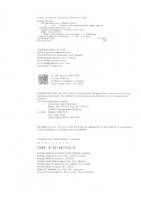Fundamentals of Microelectronics 0828525129, 9780828525121
273 3 17MB
English Pages 455 [465] Year 1982
M. n. CTenaHeHKo
2
=(*£^=(:)=
*-(* + -£ -£--£•)'■
i
/r-Ph)
t
Ie = I'e0 (eret*T _ 1) _ a,/c0 (eV-Pr _ i) (4.32a)
h = (ev«/
/d=TTTTr(F^^F»-TTllF-^l)2 (5-15>
(5.18)
i/3D vn
Stub = - - b (y*«—r0—-§• I * I)
Recommend Papers
File loading please wait...
Citation preview
FUNDAMENTALS OF M ICROELECTRONICS
M. n. CTenaHeHKo OCHOBbl MMKPOS/lEKTPOHkIKM
MaflaTe/ibCTBO « C o b 0 t c k o 6 paAno»-
MocKaa
I.R Stepanenko
FUNDAMENTALS OF MICROELECTRONICS Translated from the Russian by P.S. Ivanov
Mir Publishers Moscow
First published 1982 Revised from the 1980 Russian edition
The Greek Alphabet Aa BP r y A8
Ee Z£
H r, ©0
Ha
Alpha Beta Gamma Delta Epsilon Zeta Eta Theta
am A uucK O M
11 Kx A% Mp,
Nv sg
Oo n
jx
Iota Kappa Lambda Mu Nu Xi Omicron Pi
Pp 2a Tx Tv O
ctrons into the conduction band (a) and out into the environment (b)
&\>( — =
Valence band
(a)
— =
Vatence
band (b)
overcome a rather high potential barrier on the surface of a solid (Fig. 2.11b). The energy required for an electron to jump over this harrier is known as the w o r k f u n c t i o n , which determines the th e r m io n ic e m issio n of a solid at a given temperature. At common operating temperatures, only a very small number of electrons can store this amount of energy. So, thermionic emission has to be reckoned with only in particular cases. It is possible to liken an aggregate of free electrons in a solid to an electron gas contained, as it were, in a “vessel” formed by the external faces of a crystal. Since such a “vessel” is full of stationary atoms at lattice sites, th e p r o p e r tie s of e le c tro n s in a s o li d d if f e r fr o m th e p r o p e r tie s th e y h a v e w h en p la c e d in fre e s p a c e (vacuum). Thus the mass of an electron in a crystal differs from its mass in a vacuum. That is why the theory of solids commonly utilizes the notion of e ffe c tiv e m a ss m*, which is a few times and occasionally tens of times smaller than the mass of the electron in a vacuum (Table 2.1). Electrons excited by phonons into the conduction band leave in the valence band empty energy levels, or h o le s. These levels can be filled by electrons in the valence band, the process being equivalent to the motion of holes. In Sec. 2.3 we have given a corpuscular inter pretation of this process. The return of an electron from the conduction band onto vacant levels in the valence band results in r e c o m b in a tio n of this electron with a hole, that is, elimination of the pair of charge carriers. In the equilibrium state, the rates of thermal generation and recombination of electron-hole pairs are equal. ;*-0128
34
Ch. 2. Semiconductors Table 2.1 Basic Parameters of Some Semiconductors Parameter
Silicon
Germanium
GaAs alloy
InSb alloy
Nuclear charge Atomic mass Relative perm ittivity Melting point, °G Thermal conductivity X, W/cm °G Specific heat c, J/g °G Effective electron mass mn, in relative units Effective hole mass mp, in relative units
14 28.1 12 1420
32 72.6 16 940
__
_
At I7= 300 K Bandgap width ; 10"19 joule. The energy expressed in eV is numerically equal in Ihe corresponding potential difference.
38
Ch. 2. Semiconductors
In the theory of semiconductor devices, thermodynamic and electrical processes are closely interlinked. Since it is electrical processes that are of basic practical interest here, we shall express the energy kT in eV, equating it to #q>. One of the fundamental quantities dealt with in semiconductor physics and engineering; follows from the equality kT = gq), and is known as thermal potential: cpr = kTlq « 7711 600 (2 .1 ) It is useful to remember that at room temperature (T = 293 K), the thermal potential cpT is approximately equal to 0.025 V or 25 mV. As with the energy kT, we can express any other energy W on band diagrams in terms of the energy potential q), dividing W by q. Conduction
band
Bandgap P9 = —
Valence band
=
-
(a )
Fife. ^.14. Energy band diagrams for semiconductors at f ^ O K c and q)„ (where the subscripts c and v identify respectively the conduction and the valence band), and the difference between these levels—the width of the energy gap—as q>,, (Fig. 2.14):

![Fundamentals of Microelectronics [Prl ed.]
047007292X, 9780470072929](https://ebin.pub/img/200x200/fundamentals-of-microelectronics-prlnbsped-047007292x-9780470072929.jpg)



![Microelectronics [2nd ed]
0849333911, 9780849333910](https://ebin.pub/img/200x200/microelectronics-2nd-ed-0849333911-9780849333910.jpg)

![Mechanics of Microelectronics [1 ed.]
140204934X, 9781402049347, 9781402049354](https://ebin.pub/img/200x200/mechanics-of-microelectronics-1nbsped-140204934x-9781402049347-9781402049354.jpg)

![Women in Microelectronics [1st ed.]
9783030463762, 9783030463779](https://ebin.pub/img/200x200/women-in-microelectronics-1st-ed-9783030463762-9783030463779.jpg)
